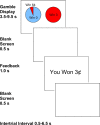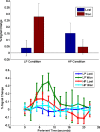Error effects in anterior cingulate cortex reverse when error likelihood is high
- PMID: 20203206
- PMCID: PMC2841347
- DOI: 10.1523/JNEUROSCI.4130-09.2010
Error effects in anterior cingulate cortex reverse when error likelihood is high
Abstract
Strong error-related activity in medial prefrontal cortex (mPFC) has been shown repeatedly with neuroimaging and event-related potential studies for the last several decades. Multiple theories have been proposed to account for error effects, including comparator models and conflict detection models, but the neural mechanisms that generate error signals remain in dispute. Typical studies use relatively low error rates, confounding the expectedness and the desirability of an error. Here we show with a gambling task and functional magnetic resonance imaging that when losses are more frequent than wins, the mPFC error effect disappears, and moreover, exhibits the opposite pattern by responding more strongly to unexpected wins than losses. These findings provide perspective on recent ERP studies and suggest that mPFC error effects result from a comparison between actual and expected outcomes.
Figures



Similar articles
-
Functional heterogeneity of conflict, error, task-switching, and unexpectedness effects within medial prefrontal cortex.Neuroimage. 2011 Jan 1;54(1):528-40. doi: 10.1016/j.neuroimage.2010.08.027. Epub 2010 Aug 20. Neuroimage. 2011. PMID: 20728547 Free PMC article.
-
From affective value to decision-making in the prefrontal cortex.Eur J Neurosci. 2008 Nov;28(9):1930-9. doi: 10.1111/j.1460-9568.2008.06489.x. Eur J Neurosci. 2008. PMID: 18973606
-
Linear age-correlated functional development of right inferior fronto-striato-cerebellar networks during response inhibition and anterior cingulate during error-related processes.Hum Brain Mapp. 2007 Nov;28(11):1163-77. doi: 10.1002/hbm.20347. Hum Brain Mapp. 2007. PMID: 17538951 Free PMC article.
-
The best of a bad bunch: the ventromedial prefrontal cortex and dorsal anterior cingulate cortex in decision-making.J Neurosci. 2007 Jan 17;27(3):447-8. doi: 10.1523/jneurosci.4967-06.2007. J Neurosci. 2007. PMID: 17240549 Free PMC article. Review. No abstract available.
-
Ventral anterior cingulate cortex and social decision-making.Neurosci Biobehav Rev. 2018 Sep;92:187-191. doi: 10.1016/j.neubiorev.2018.05.030. Epub 2018 Jun 7. Neurosci Biobehav Rev. 2018. PMID: 29886177 Free PMC article. Review.
Cited by
-
Value and prediction error in medial frontal cortex: integrating the single-unit and systems levels of analysis.Front Hum Neurosci. 2011 Aug 3;5:75. doi: 10.3389/fnhum.2011.00075. eCollection 2011. Front Hum Neurosci. 2011. PMID: 21886616 Free PMC article.
-
Different aspects of performance feedback engage different brain areas: disentangling valence and expectancy in feedback processing.Sci Rep. 2014 Aug 7;4:5986. doi: 10.1038/srep05986. Sci Rep. 2014. PMID: 25100234 Free PMC article.
-
Neural activation during risky decision-making in youth at high risk for substance use disorders.Psychiatry Res. 2015 Aug 30;233(2):102-11. doi: 10.1016/j.pscychresns.2015.05.007. Epub 2015 May 21. Psychiatry Res. 2015. PMID: 26071624 Free PMC article.
-
Distinct Regions within Medial Prefrontal Cortex Process Pain and Cognition.J Neurosci. 2016 Dec 7;36(49):12385-12392. doi: 10.1523/JNEUROSCI.2180-16.2016. Epub 2016 Nov 2. J Neurosci. 2016. PMID: 27807031 Free PMC article.
-
The Roles of Dopamine and Hypocretin in Reward: A Electroencephalographic Study.PLoS One. 2015 Nov 23;10(11):e0142432. doi: 10.1371/journal.pone.0142432. eCollection 2015. PLoS One. 2015. PMID: 26599765 Free PMC article.
References
-
- Alexander W, Brown J. A computational neural model of learned response-outcome predictions by anterior cingulate cortex. Soc Neurosci Abstr. 2008;34:682–21.
-
- Amador N, Schlag-Rey M, Schlag J. Reward-predicting and reward-detecting neuronal activity in the primate supplementary eye field. J Neurophysiol. 2000;84:2166–2170. - PubMed
-
- Barron G, Erev I. Small feedback-based decisions and their limited correspondence to description-based decisions. J Behav Decis Mak. 2003;16:215–233.
-
- Behrens TE, Woolrich MW, Walton ME, Rushworth MF. Learning the value of information in an uncertain world. Nat Neurosci. 2007;10:1214–1221. - PubMed
Publication types
MeSH terms
Grants and funding
LinkOut - more resources
Full Text Sources
